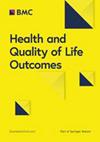Dynamic changes in quality of life in older patients with chronic obstructive pulmonary disease: a 7-year follow up
IF 3.4
2区 医学
Q1 HEALTH CARE SCIENCES & SERVICES
引用次数: 0
Abstract
: Chronic obstructive pulmonary disease (COPD) is a major cause of the rapid decline of health-related quality of life (HRQoL), associated with accelerated frailty in older populations. This study aimed to analyse the long-term dynamic changes of HRQoL and the predictive factors for the rapid decline of HRQoL in older patients with COPD. Overall 244 patients with COPD, aged ≧ 65 years from one medical centre were enrolled between March 2012 and July 2020. Further, we prospectively assessed HRQoL scores with utility values, using EuroQol Five-Dimension (EQ-5D) questionnaires. Additionally, long-term dynamic changes in HRQoL were analysed using the Kernel smoothing method and examined the factors contributing to the deterioration of HRQoL using a linear mixed effects model. Older patients with COPD with forced expiration volume (FEV1) < 50% of prediction entered the phase of rapid and continuous decline of HRQoL ~ 2 years after enrolment, but patients with FEV1 ≥ 50% of prediction without rapidly declined HRQoL during 7 years follow up. Therefore, FEV1 < 50% of prediction is a novel predictor for the rapid decline of HRQoL. The course of rapidly declining HRQoL occurred, initially in the usual activities and pain/discomfort domains, followed by the morbidity, self-care, and depression/anxiety domains ~ 2 and 4 years after enrolment, respectively. The mixed effects model indicated that both FEV1 < 50% of prediction and a history of severe acute exacerbation (SAE) requiring hospitalisation were contributing factors for deterioration in HRQoL . Both FEV1 < 50% of prediction and exacerbations requiring hospitalisation were contributing factors for the deterioration of HRQoL in long-term follow up. Additionally, FEV1 < 50% of prediction was a novel predictor for patients entering the phase of rapid decline of HRQoL.老年慢性阻塞性肺病患者生活质量的动态变化:7 年跟踪调查
:慢性阻塞性肺疾病(COPD)是导致健康相关生活质量(HRQoL)快速下降的主要原因,与老年人群的加速衰弱有关。本研究旨在分析慢性阻塞性肺病老年患者的 HRQoL 的长期动态变化以及 HRQoL 快速下降的预测因素。在 2012 年 3 月至 2020 年 7 月期间,一家医疗中心共招募了 244 名年龄≧ 65 岁的慢性阻塞性肺病患者。此外,我们还使用 EuroQol Five-Dimension (EQ-5D) 问卷对具有效用值的 HRQoL 分数进行了前瞻性评估。此外,我们还使用核平滑法分析了 HRQoL 的长期动态变化,并使用线性混合效应模型研究了导致 HRQoL 恶化的因素。强迫呼气容积(FEV1)<预测值50%的老年慢性阻塞性肺病患者在入组后2年左右进入HRQoL快速持续下降阶段,但FEV1≥预测值50%的患者在7年随访期间HRQoL没有快速下降。因此,FEV1 < 预测值的 50%是预测 HRQoL 快速下降的一个新指标。HRQoL 快速下降的过程最初发生在日常活动和疼痛/不适领域,随后是发病率、自理能力和抑郁/焦虑领域,分别发生在入组 2 年和 4 年之后。混合效应模型表明,FEV1<预测值的50%和需要住院治疗的严重急性加重(SAE)病史都是导致HRQoL恶化的因素。在长期随访中,FEV1<预测值的 50%和需要住院治疗的病情加重都是导致 HRQoL 恶化的因素。此外,FEV1 < 预测值的 50%是预测患者进入 HRQoL 快速下降阶段的一个新指标。
本文章由计算机程序翻译,如有差异,请以英文原文为准。
求助全文
约1分钟内获得全文
求助全文
来源期刊
CiteScore
7.30
自引率
2.80%
发文量
154
审稿时长
3-8 weeks
期刊介绍:
Health and Quality of Life Outcomes is an open access, peer-reviewed, journal offering high quality articles, rapid publication and wide diffusion in the public domain.
Health and Quality of Life Outcomes considers original manuscripts on the Health-Related Quality of Life (HRQOL) assessment for evaluation of medical and psychosocial interventions. It also considers approaches and studies on psychometric properties of HRQOL and patient reported outcome measures, including cultural validation of instruments if they provide information about the impact of interventions. The journal publishes study protocols and reviews summarising the present state of knowledge concerning a particular aspect of HRQOL and patient reported outcome measures. Reviews should generally follow systematic review methodology. Comments on articles and letters to the editor are welcome.

 求助内容:
求助内容: 应助结果提醒方式:
应助结果提醒方式:


